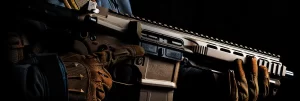Long after The Walking Dead made zombies a zeitgeist, a different kind of zombie is making headlines. Congresswoman Jill Tokuda from Hawaii is raising awareness about so-called “zombie guns” by co-sponsoring H.R. 7746 along with Representative Maxwell Frost. The proposed bill is called the “Destroy Zombie Guns Act,” and was introduced on March 20th of this year.
The focus of the legislation is to ensure that every component of a gun that has been deactivated is destroyed, rather than repurposed into a part for sale. This issue was especially salient to Representative Tokuda, due to Hawaii’s logistical challenges as an island. Hawaii has unusually strict gun laws by the standards of the continental United States and must carefully plan all its waste disposal. The bill sets a punishment of not more than 2 years in prison and a revocation of the business license of companies specializing in firearms disposal who violate proper deactivation guidelines.
This may seem like a minor issue to focus on, which is why the eye-catching name of the bill may have been intentional. When firearms are seized during a law enforcement raid, they are routinely sent to companies for decommissioning. However, for a weapon to be considered legally destroyed, only one component must be physically crushed. Other parts find their way to market, where they can be used to make untraceable guns at home.
Regular firearms are made by licensed manufacturers, stamped with serial numbers, and sold through firearms dealers. To obtain a firearm, a person must undergo a background check, a waiting period, and not be on any “red flag” lists nationwide. If a firearm is used in the commission of a crime, it can be traced by its serial number to see where it was purchased and who owns it. If parts are purchased separately, many of the individual components are not serialized. To purchase them, no background check is required. Online, the parts are advertised as “80 percent” finished lowers or receivers. T
his means that for the firearm to function, assembly of certain critical parts must be completed at home. As a result of the widespread availability of these parts on the virtual marketplace, there are untold numbers of what are called “ghost guns,” or untraceable, homemade weapons. Possession of an un-serialized weapon has long been illegal, but until recently, the parts themselves did not have to be marked or regulated.
In recent years, the Biden administration has sought to define gun kits differently so that their sale is conducted with a background check, through a licensed dealer. Additionally, the rule required some gun components to be labeled with a serial number. The “Frame or Receiver” final rule went into effect on August 24, 2022.
The rule is noteworthy for expanding the definition of a weapon to include parts crucial to the assembly of a weapon. It requires FFLs to run background checks on individuals seeking to buy kits and requires that these important components have serial numbers. It also requires dealers who have 3D printed guns or other homemade weapons in stock to have them serialized.
The rule seeks to improve tracing by requiring that records be kept for the life of the business, rather than the customary 20 years. As has been the case for all recent gun regulation attempts, lawsuits have been filed against the new rule. On October 16, 2023, the Supreme Court granted the Biden administration authority to uphold its ghost gun rules pending the appeals in the name of public safety. The justices will hear the case during their 2024-2025 term.
While the war to regulate existing gun kits rages on, this new act from Hawaii represents a novel way of approaching the problem. Whereas new gun parts are created by manufacturers and have serial numbers, many unmarked gun parts are recycled ones. The point of the Destroy Zombie Guns act is to stop the flow of these parts from the source, keeping previously deactivated parts from “coming back to life” in the form of DIY gun kits.
Since this act narrowly focuses on the behavior of companies that decommission firearms, it has a much better chance of avoiding the types of legal challenges that have dogged the ATF’s Frame and Receiver rule. It remains to be seen how much this effort will reduce the abundant supply of unregulated gun parts available on the market today.


 Kamala Harris Takes the Lead: Biden’s Withdrawal Shakes Up 2024 Presidential Race
Kamala Harris Takes the Lead: Biden’s Withdrawal Shakes Up 2024 Presidential Race